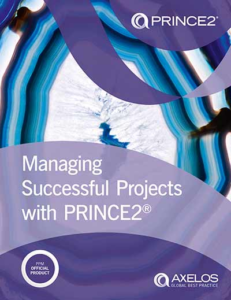
Obtaining a PRINCE2 Foundation certification is an unbelievably easy way to take a huge leap forward in your career, from technical professional into project management.
In fact, if you’re in a technical role and not looking at PRINCE2 Foundation certification you’re experiencing a huge missed opportunity cost, it’s like winning the grand prize show home at the county fair and then failing to claim the prize.
As they say where I grew up, it’s a no brainer.
Who is it For?
PRINCE2 Foundation certification is issued by Axelos in the UK. It is the lower level of two in the PRINCE2 system, the other being PRINCE2 Practitioner.
The PRINCE2 Foundation certification is a project manager “entry level” certification, for people who wish to move from a technical role into project management.
From Axelos’ website:
The Foundation certification aims to confirm that you know and understand the PRINCE2 method well enough to be able to work effectively with, or as a member of, a project management team working within an environment supporting PRINCE2.
How Prominent is PRINCE2?
PRINCE2 Foundation and its competitor, the Certified Associate in Project Management (CAPM) are the two main project manager associate certifications in the world today. Because Axelos does not publish the number of certified PRINCE2 Foundation certification holders, it is not known which one has more certifications – Suffice it to say they are relatively close. However, PRINCE2 is more prominent in the UK, and has a strong following in India, China, and Australia. The CAPM is prominent in the United States, South America, and Asia.
The IPMA Level D certification (which can be called different things in different countries), is a similar certification but has a smaller following. It has strong following in continental Europe.
Equivalents
The project management certifications equivalent to PRINCE2 Foundation are:
- Certified Associate in Project Management (CAPM). This certification is issued by the Project Management Institute (PMI) in the United States.
- International Project Management Associate, Level D (IPMA-D), issued by the IPMA in Switzerland, through member associations in each country. These member associations have quite a bit of freedom to tailor the certification to their individual circumstances, and some countries even change the name of the certification itself. For example, in the UK the official IPMA-D certification is called the Project Management Qualification (PMQ) issued by the Association for Project Management (APM).
Education Requirements
There is no background education requirement such as a secondary or post-secondary degree to obtain PRINCE2 Foundation certification.
You also do not need to take any courses to qualify to write the exam.
Experience Requirements
There are no project management experience requirements to take the PRINCE2 Foundation exam and become certified.
Official Textbook
 The official textbook is called Managing Successful Projects with PRINCE2, (2017 edition), written by Axelos.
The official textbook is called Managing Successful Projects with PRINCE2, (2017 edition), written by Axelos.
Cost
The official textbook is sold directly from the Axelos website for £85 (at the time of this writing), or from Amazon.
In addition to the textbook there is a cost for writing the exam. If you write the exam directly through PeopleCert, the price at the time of this writing is US$314.
Any training courses taken prior to writing the exam are in addition to this.
The Exam
You can study the manual privately and then take the exam at PeopleCert, or you can take a course from an Accredited Training Organization and write the exam directly through them.
The 60 minute, open book exam has 60 questions, which are all multiple choice. The passing grade is 55% (33 out of 60).
Expiry
The PRINCE2 Foundation certification does not expire.
The PRINCE2 Methodology
PRINCE2, as documented in the official guide Managing Successful Projects with PRINCE2, is divided into three sections:
- Seven Principles
- Seven Themes
- Seven Processes
PRINCE2 Principles
 Principles are universal guiding obligations and good practices that apply to all projects. The seven principles are:
Principles are universal guiding obligations and good practices that apply to all projects. The seven principles are:
- Continued Business Justification. The project must always be grounded in a business case. This justification must be documented, approved, and continually re-validated throughout the life of the project.
- Learn from Experience. The project must learn from previous projects, and ensure that knowledge gained throughout the project is passed on to future projects.
- Defined Roles and Responsibilities. All projects must have an explicit project management team structure, which consists of well defined roles and responsibilities.
- Manage by Stages. PRINCE2 projects must break the project into discrete components called management stages. These are similar to project phases. For simple projects, there must be at least two stages, an initiation stage and an execution stage.
- Manage by Exception. The tolerances of the project’s products must be well defined and measured. Controls must be in place to keep them within tolerance.
- Focus on Products. PRINCE2 projects must be output-focused rather than work-focused. That is, it must be focused on the definition and delivery of products rather than work processes.
- Tailor to Suit the Project. The project management methods must be adjusted to suite the project environment, size, complexity, importance, team capability and risk level.
PRINCE2 Themes
 The PRINCE2 themes are subject areas that must be addressed continually throughout the project. The seven themes are:
The PRINCE2 themes are subject areas that must be addressed continually throughout the project. The seven themes are:
- Business case: The investment proposition on which the project is built.
- Organization: The roles and responsibilities of the project team, executive, project board, etc.
- Quality: The specifications for project quality, how it is measured and what the remedial actions are.
- Plans: Project plans such as schedules, budgets, and work packages.
- Risk: The risk profile of the project, tracking of project risks and management of risk tolerances.
- Change: Policies and procedures relating to project changes – to the schedule, budget, or any other item within the plans.
- Progress: The ongoing monitoring and controlling activities to ensure the project is proceeding as planned.
PRINCE2 Processes
 The processes are the action based procedures that are carried out throughout the stages of the project life cycle, from initiation to project closure. Each process contains checklists of recommended tasks, products that must be produced, and associated responsibilities.
The processes are the action based procedures that are carried out throughout the stages of the project life cycle, from initiation to project closure. Each process contains checklists of recommended tasks, products that must be produced, and associated responsibilities.
The seven PRINCE2 Processes are:
- Starting up a project: This process involves the preparation of the project brief, appointing the project management team and planning the initiation stage.
- Directing a project: The project board is the primary undertaker of this activity, which spans all of the other activities. It involves authorizing the project and each of its management stages, including project closure.
- Initiating a project: Primarily performed by the project manager, this process involves the preparation of the project plans, including the Project Initiation Document (PID). This document contains all of the project planning information, such as Communications Approach, Communications Approach, Quality Management Approach, Project Controls, and Change Control Approach.
- Controlling a stage: Each management stage must consist of authorized work packages, which are monitored and controlled, and related issue tracking.
- Managing product delivery: This low level task is primarily carried out by the team manager (or project manager for small projects) and involves the day to day assignment of work tasks.
- Managing a stage boundary: This process involves planning of the next management stage, updating the project plan, and preparing for the next stage of the project.
- Closing a Project: As the project finishes, the tasks required to close the project and review the benefits achieved fall into this, final, process.
After reading this, do you think your boss would appreciate this project management knowledge over the technical knowledge you are already good pretty good at?
Take control of your career by obtaining a PRINCE2 Foundation certification. It’s time to collect the prize that is sitting there idling, waiting to be claimed.






